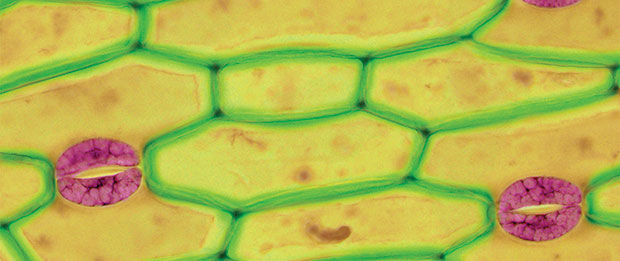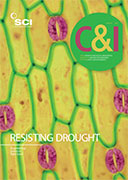Analysis of extreme weather disasters from 1964 to 2007 revealed that, on average, 10% of all crop production was lost every year to drought and extreme heat. The situation seems to be getting worse, with annual losses averaging 6.7% until 1984, rising to 13.7% between 1985 and 2007.1
‘Regionally there is an understanding that climate change will lead to an increase in drought events,’ says Pedram Rowhani, author of this 2016 weather disasters analysis, which looked at aggregate Food and Agriculture Organization (FAO) data of 16 crops. Heat stress happens over short time periods, but drought happens over longer timescales and is linked to drier soils. Maize and wheat are especially hard hit, with yields falling up to 50% if drought hits as the plants set seed after pollination.
In the red high plains of the central US, the country’s largest wheat-growing region, drought is a possibility nearly every season. ‘Drought stress can be a key concern, especially in dry lands of North America, but even in irrigated areas we can’t expect the same levels of water in future and farmers face restrictions,’ says Chris Souder, crop scientist at Monsanto.
Groundwater depletion means the problem is here to stay. A first measure of our thirst for groundwater linked to world trade was published in spring 2017.2 It warned of alarming depletion due to farm irrigation. As much as 11% of non-renewable groundwater resources is sent out of a country in food; two-thirds are accounted for by the combined exports of Pakistan, the US and India alone.
This is not simply a developing world problem. Rowhani was surprised to find that cereals in more technically developed agricultural systems of North America, Europe and Australia suffered most from droughts. Yield losses due to drought were 19.9% in the US, 12.1% in Asia, 9.2% in Africa and almost no effect in Latin America. ‘Any shifts in weather can have disastrous impacts on what are highly optimised agri-systems,’ says Rowhani.
Crop breeders in the past paid a great deal of attention to yield, but not enough to resilience to extreme events such as drought, he adds. But this is changing. Growers increasingly want built-in drought resilience and plant scientists are looking for novel solutions. A recent study warned that the process of breeding, delivery and adoption of new maize varieties can take up to 30 years.3 New, unconventional approaches based on novel insights from basic science might be necessary.
Plant strategies
Hundreds of genes and proteins are involved in the complex trait of drought resistance. Plants avoid drought stress by shortening their life cycle with accelerated flowering, or cut down water loss by closing leaf pores called stomata. Other strategies include increasing the thickness of the leaf cuticle or boosting water uptake by having deeper, thicker root systems. One approach by breeders is to target specific traits by crossing individual plants that perform best under drought conditions.
‘About 97% of plant water loss occurs through the stomata. If you want to regulate the amount of water a plant uses, regulate the stomata,’ says Julie Gray, plant scientist at the University of Sheffield, UK. But plants face a dilemma: they must open their stomata to take in carbon dioxide, so it’s a trade-off between needing carbon and retaining water. Plants naturally vary their stomatal density by a few percentages at high CO2 levels, although Gray suspects highly bred crop plants may not be as versatile as their wild ancestors.
Gray has been genetically tweaking wheat, barley and rice plants so they have fewer stomata. She believes rising CO2 levels in the atmosphere means that they need not suffer from less carbon dioxide. ‘CO2 levels have gone up 40% over the last 200 years. It’s quite possible they are producing more stomata than they need,’ says Gray. Current CO2 concentrations are 390ppm, but this could reach 450ppm in the next 25 to 30 years.
Back in 2012, Gray and coworkers reported that plants grown at 450ppm CO2 with reduced stomatal density but increased stomatal size had larger biomass and increased growth tolerance when water was limited.4 ‘We can dramatically reduce the number of stomata and still get enough CO2 into the plant for photosynthesis. We haven’t yet pinned down a number, but plants can operate with perhaps half as many stomata before you see significant effects on photosynthesis, so you can definitely reduce water loss this way,’ says Gray.
She has worked with the International Rice Research Institute in the Philippines and recently used CRISPR-Cas gene editing to modify stomatal numbers in rice.5 However, there is one downside to fewer stomata: losing water through leaf pores cools a plant down, and hotter plants might suffer heat stress. One solution is to have fewer stomata in vulnerable young plants, so conserving water during this time, but step up stomata numbers as the reproductive parts develop. In effect, equipping the plant with more heat valves during seed set.
Root of the issue
At the other end of the plant plumbing system are roots. The conventional approach is to breed stress-tolerant cultivars with deep root architecture, for example, but this is time and labour intensive and neglects the soil environment, argues Susannah Tringe, microbiologist at the Joint Genome Institute in California, US.
Instead, Tringe is seeking microbes that can gift stress-tolerance to their plant hosts. ‘The microbes associated with plants are likely to be just as important for plant growth and health as the microbiome of humans,’ says Tringe. Moreover, it is widely held that we have bred out of crop plants their natural relationships with beneficial microbes by providing them with everything. For example, giving legume plants lots of nitrogen discards nitrogen-fixing alliances. ‘There’s no motivation for the plant and microbe to work together,’ Tringe explains. If breeding takes place in optimal conditions only, then genes needed for the plant microbome to work smoothly might mutate and so plants lose resilience.
Tringe argues that traditional crop breeding has overly focused on the plant genome. In a review paper in 2014, she notes that farming will increasingly move onto marginal, arid and semi-arid lands, which can present water availability challenges.6
Their old microbial allies may help crops to continue to grow well under suboptimal conditions, she believes, pointing to two recent studies which found that more than a quarter of bacteria isolated from cultivated crops had plant-promoting activities.7, 8
An Italian study in 2015 tested eight microbial isolates for their ability to support grapevine growth under water stress. Three increased grapevine root biomass and boosted plant adaptation to drought.9 Tringe describes this as an ‘orthogonal direction’ for plant breeders, but one with a lot of potential. Surprisingly, a US study showed that soil microbes can even alter plant traits such as flowering time.10 Tringe is currently conducting greenhouse experiments trying to figure out factors that influence how microbes form a community in association with plants.

She is collaborating with colleagues in Nebraska, US, to grow fields of sorghum with different plant genotypes to see what microbial community they support. As well as the soil type and field location, plant genetics also help determine what microorganisms grow around the roots. Though a lot of work has focused on finding the ‘magic microbe,’ Tringe believes whole communities will be necessary in real field conditions, whereas a single strain could be out-muscled by competitors.
She has been surprised by the interest in this area by industry. ‘I’ve talked to people from Monsanto, BASF, and Bayer and they all have microbiome research programmes under way,’ she says, adding that a huge body of knowledge is building up which is not yet available in the public literature.
Sugar and drought
‘Drought is probably the most widespread abiotic stress that limits food production worldwide. There is always need to improve drought tolerance,’ says Matthew Paul, plant scientist at Rothamsted Research Institute in the UK: ‘Even in the UK it can significantly reduce yield when it happens as reproductive structures are being formed.’ While traditional plant breeding programmes are quite slow, delivering incremental gains of 1-2%, he notes that these have been boosted by modern genetic techniques and robotics that measure a variety of crop attributes.
‘Traditionally breeders have used statistical methods to look at individuals, but now they can look at pieces of the genome and see which ones are doing most good,’ explains Graeme Hammer, a plant scientist at the University of Queensland who has studied the shifting influence of drought in Australia.11 DNA sequencing allows these pieces to be tracked and the best combinations to be made. ‘You can make advances using statistical quantitative biology, without knowing much about what the genetics does. But we argue if you understand what is going on, then you can do things with complex traits like roots structure or how they canopy grows far more effectively,’ Hammer says.
Indeed, Paul notes that the green revolution of the 1960s was driven by a reduction in stem height, which involved a handful of genes. He believes a few genes can deliver windfall gains under drought conditions. ‘It may be possible to combine good productivity with resilience under difficult growing conditions. We think we can do it through the way plants manage their carbon budgets,’ he explains, adding that this can be achieved either by genetic modification or natural genetic variation.
‘Sucrose is produced in photosynthesis,’ Paul explains. ‘During drought conditions, plants will withhold sucrose from the grain, as a survival mechanism.’ This can terminate reproductive structures and abort seed formation, even if drought is short lived, greatly compromising yield. Maize is especially susceptible to drought during its two- to three-week flowering period. Rothamsted researchers have looked at modifying plants so the sugar keeps flowing. ‘If you can get more sugar going to where you want it - the ears - then this could improve yields and yield resilience,’ enthuses Paul.
He has achieved this by genetically tweaking the trahalose 6 phosphase (T6P) pathway, which controls where the sugar goes and how much a plant puts towards growth. A gene for a rice T6P enzyme was over-expressed in developing maize ears, which reduced the concentration of T6P in the ears and led to a surge in sugar there. Field studies over multiple seasons showed that the GM maize improved yields form 9 to 49% under non-drought and mild drought conditions, and from 31 to 123% under severe drought, when compared with non-transgenic maize plants.12
In a collaboration with the department of chemistry at the University of Oxford, UK, in 2016, Paul’s group also showed that chemical intervention was another viable strategy.13 The Oxford chemists altered the polarity of a precursor of T6P so that plants could take it up. This compound was then sprayed onto a plant and sunlight triggered release of T6P once inside. Spraying vegetative tissues improved recovery of wheat following drought. Spraying spring wheat on the ears increased starch content by 13 to 20%.
‘What T6P is doing is activating genes for starch synthesis in the grain. More starch means bigger grains. We are hoping to trial this in the field this year. We are hoping to link up with a commercial partner, who we are negotiating with now,’ Paul says. This chemical approach circumvents the need to breed special varieties of wheat or maize, while a sugar allocation strategy could improve yield in good years and bad.
References
1 Nature, doi: 10.1038/nature16467
2 Nature, doi:10.1038/nature21403
3 Nature Climate Change, doi: 10.1038/NCLIMATE3061
4 Phil. Trans. R. Soc. B, doi: 10.1098/rstb.2011.0272
5 Plant Cell Rep, doi: 10.1007/s00299-017-2118-z
6 Frontiers in Microbiology, doi: 10.3389/fmicb.2014.00283
7 Biocontrol, doi:10.1007/s10526-010-9268-z
8 PloS One, doi: org/10.1371/journal.pone.0048479
9 Environmental Microbiology, doi: 10.1111/1462-2920.12439
10 The Isme Journal, doi:10.1038/ismej.2014.196
11 Global Change Biology, doi: 10.1111/gcb.1302)
12 Nature Biotech., doi:10.1038/nbt.3277
13 Nature, doi:10.1038/nature20591





